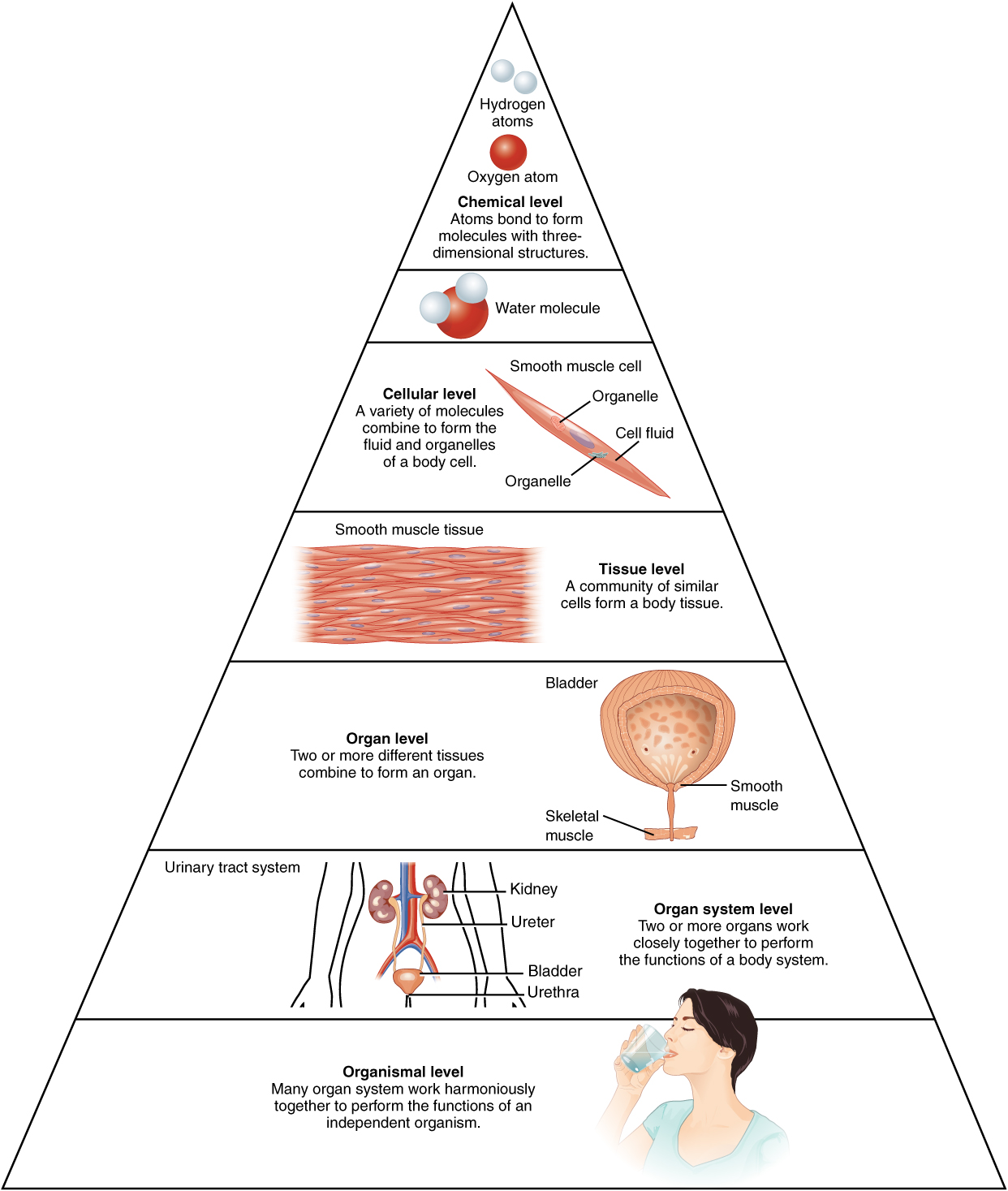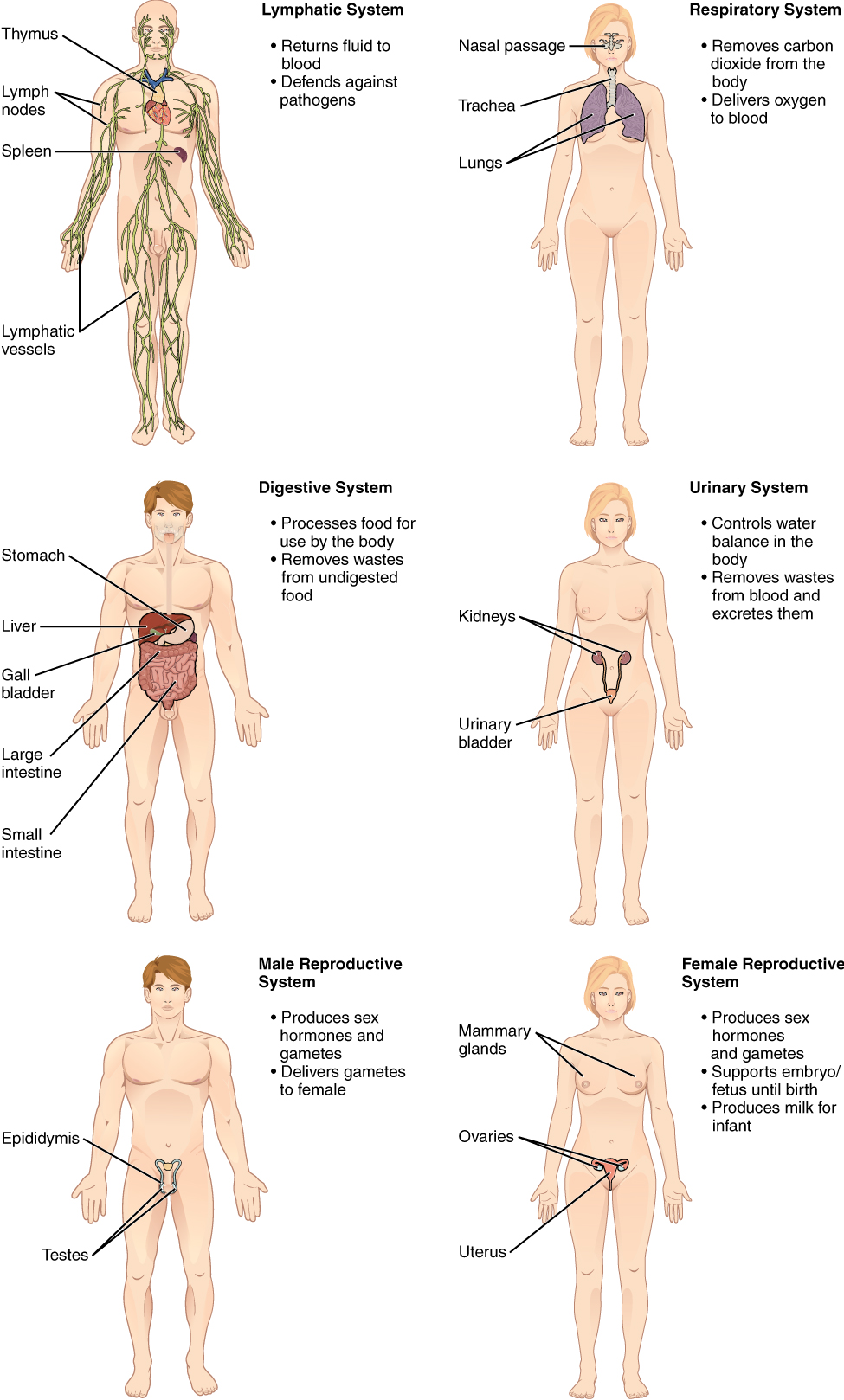1.3: Structural Organization of the Human Body
- Page ID
- 22247
By the end of the section, you will be able to:
- Describe the structure of the human body in terms of six levels of organization
- List the eleven organ systems of the human body and identify at least one organ and one major function of each
Before you begin to study the different structures and functions of the human body, it is helpful to consider its basic architecture; that is, how its smallest parts are assembled into larger structures. It is convenient to consider the structures of the body in terms of fundamental levels of organization that increase in complexity: atoms, molecules, organelles, cells, tissues, organs, organ systems, and organisms (Figure \(\PageIndex{1}\)).

The Levels of Organization
To study the smallest level of organization, scientists consider the simplest building blocks of matter: atoms and molecules. The chemical level of organization considers these two building block as atoms bond to form molecules with three dimensional structures. All matter in the universe is composed of one or more unique pure substances called elements, familiar examples of which are hydrogen, oxygen, carbon, nitrogen, calcium, and iron. The smallest unit of any of these pure substances (elements) is an atom. Atoms are made up of subatomic particles such as the proton, electron and neutron. Two or more atoms combine to form a molecule, such as the water molecules, proteins, and sugars found in living things. Molecules are the chemical building blocks of all body structures.
The cellular level is considered when a variety of molecules combine to form the fluid and organelles of a body cell. A cell is the smallest independently functioning unit of a living organism. Even bacteria, which are extremely small, independently-living organisms, have a cellular structure. Each bacterium is a single cell. All living structures of human anatomy contain cells, and almost all functions of human physiology are performed in cells or are initiated by cells. A human cell, such as a smooth muscle cell, typically consists of flexible membranes that enclose cytoplasm, a water-based cellular fluid together with a variety of tiny functioning units called organelles.
The tissue level can be studied when a community of similar cells form a body tissue. A tissue is a group of many similar cells (though sometimes composed of a few related types) that work together to perform a specific function. For example, when many smooth muscle cells come together both structurally and functionally, these cell collectively form a layer of smooth muscle tissue.
An organ is an anatomically distinct structure of the body composed of two or more tissue types, which forms the organ level of organization. Each organ performs one or more specific physiological functions. The human bladder, which is composed of smooth muscle tissue, transitional epithelial tissue, and several types of connective tissue serves the function of storing urine produced by the kidneys.
An organ system level is a group of organs that work together to perform major functions or meet physiological needs of the body. In the organ example above, both the kidneys and the bladder are organs of the urinary system. The kidneys produce urine, which is moved to the bladder by the ureters. Urine can then leave the bladder, and the body, through the urethra. These four organs work together to rid the body of liquid waste.
This book covers eleven distinct organ systems in the human body (Figure \(\PageIndex{2}\) and Figure \(\PageIndex{3}\)). Assigning organs to organ systems can be imprecise since organs that “belong” to one system can also have functions integral to another system. In fact, most organs contribute to more than one system.
.jpg?revision=1&size=bestfit&width=470&height=777)
.jpg?revision=1&size=bestfit&width=470&height=780)
The eleven distinct organ systems in the human body covered in this book seen in Figure \(\PageIndex{2}\) and Figure \(\PageIndex{3}\) include:
- The integumentary system functions to enclose internal body structures and is the site of many sensory receptors. Some organs of this system include skin, hair, and nails.
- The skeletal system supports the body and enables movement (with the help of the muscular system). Bones are the major organs of this system.
- The muscular system enables movement (with the help of the skeletal system) and also helps to maintain body temperature. Skeletal muscles are the major organs of this system, which are connected to bones by tendons.
- The nervous system detects and processes sensory information and activates bodily responses. The main organs that perform these functions are the brain, spinal cord, and peripheral nerves.
- The endocrine system is responsible for secreting hormones to regulate bodily processes. Some major organs of the endocrine system include the pituitary gland, thyroid gland, pancreas, adrenal glands, testes, and ovaries.
- The cardiovascular system delivers oxygen and nutrients to tissues while also removing wastes, and helps to equalize temperature in the body. This is accomplished by the heart and blood vessels.
- The lymphatic system functions to return fluids back to the blood and defends the body against pathogens. Major structures and organs of this system include the thymus, lymph nodes, the spleen, and lymphatic vessels.
- The respiratory system delivers oxygen to blood and removes carbon dioxide from the body. The nasal cavity, trachea, and lungs all work together to carry out these functions.
- The digestive system processes food for use by the body and removes wastes from undigested foods. Some organs of the digestive system include the stomach, liver, gallbladder, large intestine, and small intestine.
- The urinary system controls water balance in the body and removes wastes from the blood and excretes them. The kidneys and bladder are major organs of this system.
- The reproductive system produces sex hormones and gametes. The male reproductive system also functions to deliver gametes to the female, while the female reproductive system supports an embryo/fetus until birth and produces milk for an infant. Organs of the male reproductive system include the epididymis and testes. Organs of the female reproductive system include the mammary glands, ovaries, and the uterus.
While only some functions and major organs of each system have been listed above, each of these organ systems will be covered in much greater detail in the following chapters of this book.
The organism level, when many organ systems work harmoniously together to perform the functions of an independent organism, is the highest level of organization in the study of human anatomy. An organism is a living being that has a cellular structure and that can independently perform all physiologic functions necessary for life. In multicellular organisms, including humans, all cells, tissues, organs, and organ systems of the body work together to maintain the life and health of the organism.
Concept Review
Life processes of the human body are maintained at several levels of structural organization. These include the chemical, cellular, tissue, organ, organ system, and the organism level. Higher levels of organization are built from lower levels. Therefore, molecules combine to form cells, cells combine to form tissues, tissues combine to form organs, organs combine to form organ systems, and organ systems combine to form organisms.
Review Questions
Q. The smallest independently functioning unit of an organism is a(n) ________.
A. cell
B. molecule
C. organ
D. tissue
- Answer
-
Answer: A
Q. A collection of tissues that performs a specific function is an ________.
A. organ
B. organelle
C. organism
D. organ system
- Answer
-
Answer: A
Q. The body system responsible for structural support and movement is the ________.
A. cardiovascular system
B. endocrine system
C. muscular system
D. skeletal system
- Answer
-
Answer: D
Critical Thinking Questions
Q. Name the six levels of organization of the human body.
- Answer
-
A. Chemical, cellular, tissue, organ, organ system, organism.
Q. The female ovaries and the male testes are a part of which body system? Can these organs be members of more than one organ system? Why or why not?
- Answer
-
A. The female ovaries and the male testes are parts of the reproductive system. But they also secrete hormones, as does the endocrine system, therefore ovaries and testes function within both the endocrine and reproductive systems.
Glossary
- cardiovascular system
- organ system that delivers oxygen and nutrients to tissues while also removing wastes, and helps to equalize temperature in the body
- cell
- smallest independently functioning unit of all organisms; in animals, a cell contains cytoplasm, composed of fluid and organelles
- cellular level
- a variety of molecules combine to form the fluid and organelles of a body cell
- chemical level
- atoms bond to form molecules with three dimensional structures
- cytoplasm
- a water-based cell fluid
- digestive system
- organ system that processes food for use by the body and removes wastes from undigested foods
- endocrine system
- organ system that is responsible for secreting hormones to regulate bodily processes
- integumentary system
- organ system that functions to enclose internal body structures and is the site of many sensory receptors
- lymphatic system
- organ system that returns fluids back to the blood and defends the body against pathogens
- muscular system
- organ system that enables movement and maintains body temperature
- nervous system
- organ system that detects and processes sensory information and activates bodily responses
- organ
- functionally distinct structure composed of two or more types of tissues
- organ level
- two or more different tissues combine to form an organ
- organ system level
- group of organs that work together to carry out a particular function
- organelles
- a variety of tiny functioning units within a cell
- organism
- living being that has a cellular structure and that can independently perform all physiologic functions necessary for life
- reproductive system
- organ system that produces sex hormones and gametes
- respiratory system
- organ system that delivers oxygen to blood and removes carbon dioxide from the body
- skeletal system
- organ system that supports the body and enables movement
- tissue
- group of similar or closely related cells that act together to perform a specific function
- tissue level
- a community of similar cells form a body tissue
- urinary system
- organ system that controls water balance in the body and removes wastes from the blood and excretes them
Contributors and Attributions
OpenStax Anatomy & Physiology (CC BY 4.0). Access for free at https://openstax.org/books/anatomy-and-physiology


